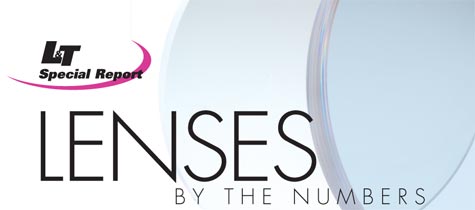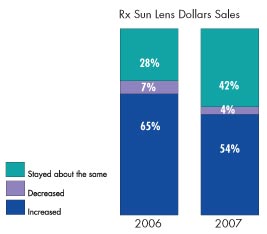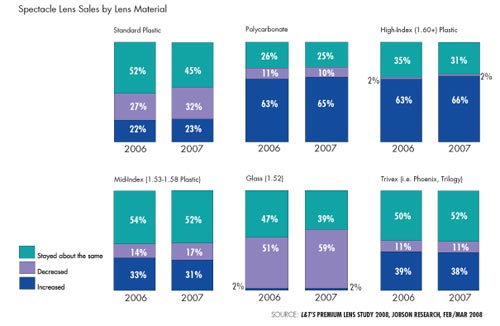
L&T’s 2008 Premium Lens Study of Eyecare Practitioners is a qualitative survey that provides fresh feedback from eyecare practitioners about sales of spectacle lens designs, materials and treatments they prescribe and dispense. By analyzing the results of this important study, which polled 303 independent optical retailers across the country, we learned which products they think are hot and which ones are not compared with last year. Use this field data to benchmark lens sales in your own dispensary.
—Andrew Karp
 Total Sales
Total Sales
Compared to three years ago, 74 percent of retailers say that in 2007, spectacle lenses and treatments made up a larger percentage of their location’s total gross dollar sales. This is up from 72 percent in 2006. There was also a decrease in the number of retailers who say spectacle lenses and treatments made up a smaller percentage compared to three years ago, going from 8 percent in 2006 to 5 percent in 2007. Fifty- four percent say that Rx sun lenses as a percentage of total dollar sales increased over three years ago.
Lens Sales
When asked to rank lens design by popularity, single-vision was ranked number one by 62 percent of retailers. Progressive (including short corridor) was ranked one by 32 percent. Sixty-one percent of retailers say short corridor lenses made up a moderate percent (11 percent to 49 percent) of their total progressive lens pair sales.
Almost half (49 percent) of retailers say that single-vision lenses made up a greater proportion of their total lens sales in 2007 than they had in 2006. Comparatively, 84 percent say progressive sales had increased over the last year, while 46 percent say sales of bifocals and trifocals had decreased as a percentage of total lens sales over the last year.
Forty-six percent of retailers say brand name is “very important” to them regarding their decision as to which lenses to carry. Also, 77 percent of retailers say quality is “extremely important” to them regarding their decision as to which lenses to carry.
Ninety-three percent of retailers say quality is “very” or “extremely important” to their patients regarding their decision as to which lenses to purchase. Forty percent of retailers say price is “extremely important” to their patients in regard to their decision as to which lenses to purchase.
Eight-one percent of retailers agree with the statement, “I promote the use of progressive lenses to all my presbyopic patients, including those who currently wear bifocals or trifocals.”

Computer/Office Lenses
Computer vision sales have stayed about level, with 54 percent of retailers saying their sales in this area have remained unchanged. Most retailers surveyed (66 percent) say computer/office lenses make up an insignificant percentage (10 percent or less) of their total lens pair sales.

Lens Materials
When asked to rank lens material by popularity, standard plastic was ranked number one by almost half (44 percent) the retailers. Polycarbonate was ranked one by 40 percent. Glass was ranked least popular by the most retailers (69 percent).
Sixty-five percent of retailers say their 2007 polycarbonate lens sales increased as a proportion of total lens pair sales compared to 2006. Sixty-six percent say their sales of high-index lenses had grown since 2006 and 38 percent say Trivex sales had increased over the last year.
Fifty-two percent say their mid-index lens sales had stayed flat. Glass was the worst performer, with 59 percent saying glass made up a smaller proportion of their total lens sales in 2007 than in 2006.
 High-Index Lenses
High-Index Lenses
When asked to rank high-index lenses based on popularity, 46 percent ranked 1.67 as most popular and 41 percent ranked 1.60 as most popular. Comparatively, 1.74 was ranked least popular by 65 percent of retailers.
Lens Treatments
An impressive 86 percent of retailers surveyed say they had experienced an increase in AR lens sales as a proportion of total lens sales in 2007 vs. 2006. Seventy-three percent saw an increase in polarized lenses and 72 percent saw an increase in photochromic sales over the same period.
For 42 percent of retailers surveyed, tinted lens sales stayed about the same versus the year before.
Sixty-three percent of retailers say they offer two different price points for AR lenses—one being standard, the other being premium.
Impact of Refractive Surgery
Nine percent of retailers agree that because of the increase in patients having refractive surgery their overall lens sales have decreased. Twenty-one percent say specifically high-powered lens sales have decreased.
Reading Glasses
For some retailers (37 percent), reading glass unit sales stayed about the same in 2007 compared to 2006. Thirty-eight percent of respondents experienced an increase in readers sales over this time period. Among those who sell readers, 34 percent say their OTC/ready-made readers sales had increased in 2007. Custom-made readers sales were flat for half (50 percent) of respondents at locations that sell readers.
Lens and Lens Treatment Packages
When asked about familiarity regarding new progressive lens technologies, three-quarters of respondents were aware of the term “free-form progressives.” Seventy-nine percent are aware of the term “digitally surfaced progressives” and only 44 percent are aware of the term “direct surfaced progressives.”
Seventy-one percent of respondents say they are “very” or “extremely satisfied” with the personalized progressive lenses they dispense.
Forty-seven percent of retailers say they do use lens-only package pricing. The average price of this lens-only package is $253.38.
Methodology
L&T’s Premium Lens Study 2008 reports on the premium lens sales practices and offerings of 303 independent optical retailers. This sample was derived from the propriety Jobson Database. All participants were contacted via email invitation and offered an incentive of a chance to win a $200 American Express gift card. The study was fielded February 27, 2008 to March 10, 2008. When information is available, two-year comparisons are provided. Last year’s 166 participants were also contacted via email invitation and offered an incentive of a chance to win a $200 American Express gift card.Both studies were conducted in February and March. Given this, the analysis may reflect seasonal market changes. Also, as with any voluntary survey discussing premium products, the sample may include retailers that provide higher end lens products and are more technologically savvy than the national average.
L&T’s Premium Lens Study 2008 reports on the premium lens sales practices and offerings of 303 independent optical retailers. This sample was derived from the propriety Jobson Database. All participants were contacted via email invitation and offered an incentive of a chance to win a $200 American Express gift card. The study was fielded February 27, 2008 to March 10, 2008. When information is available, two-year comparisons are provided. Last year’s 166 participants were also contacted via email invitation and offered an incentive of a chance to win a $200 American Express gift card.Both studies were conducted in February and March. Given this, the analysis may reflect seasonal market changes. Also, as with any voluntary survey discussing premium products, the sample may include retailers that provide higher end lens products and are more technologically savvy than the national average.
—Jennifer Zupnick and Beth Briggs, market research analysts













